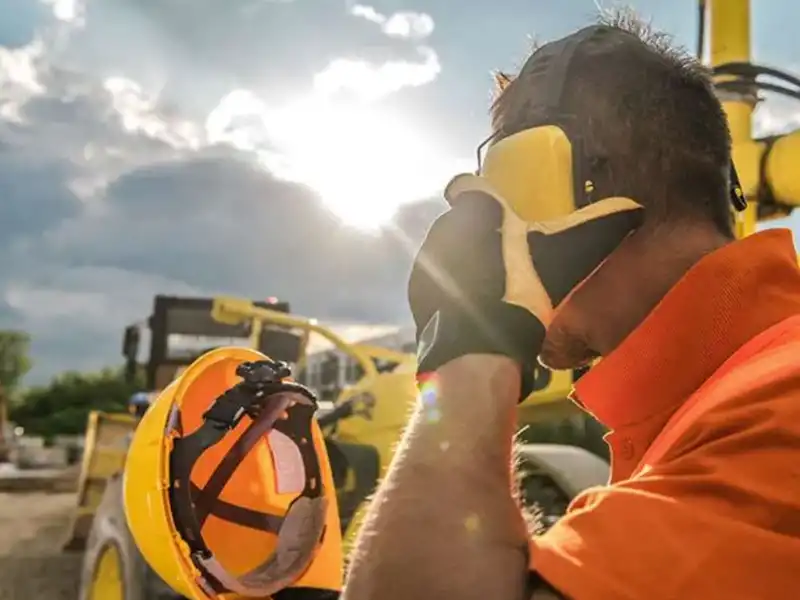States we serve: VA, MD, DC, PA, NC, SC, and WV
Construction Site Hazards: Identifying and Mitigating Risks
July 17, 2023 · 4 minute read

Have questions?
Contact us today.
Phone: (703) 471-0050
Please note: coverage cannot be bound or altered online. A service representative will need to contact you to finalize your request.
The construction industry continues to lead national statistics for workplace fatalities, accidents, and injuries. In 2021, 20 percent of the 5,190 fatal workplace accidents happened on a construction site.
To increase the safety of your team, it is important to identify and mitigate the risks your workers face on-site. Taking a closer look at accident statistics reveals some of that information. However, it is also important to review your own safety protocols and procedures to ensure your workers’ health and well-being. Read on to learn more about the biggest risks on construction sites and how to mitigate them.
Common Construction Site Hazards: A Comprehensive Overview
Without understanding the risks construction workers face in their jobs, employers cannot meet their duty of care for their teams. Individual risks may vary among jobs and sites, but some of the most common risks apply to the majority of job sites.
1. Falls from Heights
Construction site fatalities due to slips, trips, and falls make up the largest part of workplace fatalities in the sector. In 2021, these accidents were responsible for one in three fatalities in construction. If that number does not sound alarming enough, consider this: the construction industry alone accounted for more than 44% of all fatalities from slips, trips, and falls.
The message could not be clearer. Falls from heights pose a serious risk to construction workers and minimizing these incidents should take priority for all construction companies. Additionally, falls from a lower height account for 82% of falls within the sector. The number of falls at the same level is negligible in comparison.
2. Noise and Vibration Hazards
Noise and vibration may not seem like serious hazards at first thought. However, examining their effect on construction workers makes it clear why both pose risks.
The main risk associated with noise exposure is damaged hearing or hearing loss. While our ears have been designed to protect themselves if noise exceeds a certain level, long-term exposure can still cause permanent damage. Excessive noise also leads to fatigue, raised stress levels, and poor productivity, among other effects. These reasons are why it’s crucial to prioritize using the right hearing protection in the workplace. By providing employees with appropriate ear protection gear and ensuring its proper usage, we can significantly reduce the risk of hearing damage.
Excessive vibration from hand-held machinery is transmitted into a worker’s arms and hands. Over time, this type of exposure may cause nerve damage and affect blood vessels, muscles, and joints. Workers could also develop hand-arm vibration syndrome, which can be career-ending.
3. Electrocution and Other Electrical Hazards
In most cases, construction demands extensive electrical installations. As individuals and businesses rely increasingly on electronic gadgets, most construction sites have a team of electricians on site, ensuring installations are completed safely.
Still, high-voltage electrical injuries continue to cause approximately 400 deaths per year in the United States. In addition, there are at least 30,000 non-fatal electric shock incidents. While children account for one in five of these injuries, adults face a higher risk. Plus, research shows that most electrical accidents among adults happen in work settings.
4. Structural Hazards
Just as falling from a height creates hazards for workers on construction sites, there are also structural hazards from falling objects, machinery, or collapsing structures.
It is not uncommon for trenches to collapse with workers inside. Despite careful planning, buildings being demolished may also collapse unexpectedly.
5. Machinery, Material, and Equipment Hazards
Construction workers may also face a range of hazards from the machinery they operate, the equipment they use, and the materials to which they are exposed.
Asbestos is one of the most dangerous building materials that used to be widely used in construction. Even though that is no longer the case, workers still become exposed to asbestos when doing conversions or removing it from older buildings.
Modern construction requires heavy machinery and an assortment of equipment with varying degrees of sophistication. Operating any equipment without proper training exposes workers to risks they are most likely unaware of.
Training and Education: Empowering Workers with Knowledge and Awareness
Increasing your team’s knowledge and awareness of existing hazards is an excellent starting point, but you need to go further by sharing knowledge of how to avoid those dangers, including:
- Using personal protective equipment (PPE) when working with hazardous materials or in potentially dangerous environments.
- Offering a range of fall protection equipment specific to the site and training the team in its use.
- Ensuring anyone operating heavy machinery has access to adequate training and PPE to use the equipment safely.
Best practice for employers includes regularly and consistently offering training opportunities that are accessible to the entire team.
Job Site Inspections and Safety Audits: Regular Evaluations for Risk Prevention
Regular job site inspections and safety risk evaluations may seem disruptive. However, as part of fostering a company-wide safety culture, they are essential in showing the team where improvement is needed.
For inspections and audits to be effective, the team needs to know the goal is not to find fault and point fingers but instead to strengthen safety protocols for the benefit of everyone.
Regulatory Compliance: Adhering to Local and National Safety Standards
Safety standards set out by the Occupational Safety and Health Administration at a national and local government level provide a framework for employers. These guidelines offer generic but helpful advice for protecting workers on construction sites.
While these guidelines can form the foundation of individual policies, they are not a replacement for site-specific inspections and risk assessments.
Conclusion
Working in the construction industry does carry risks, some of which may not be immediately obvious. It’s for this reason employers need to start projects and jobs by identifying common site hazards and risks their employees may face before developing strong procedures and protocols to protect teams.
National and local regulations can form the basis of procedures and protocols but educating workers and carrying out regular site inspections remain essential to keeping construction workers safe.



.jpg/500w/webp/60q)